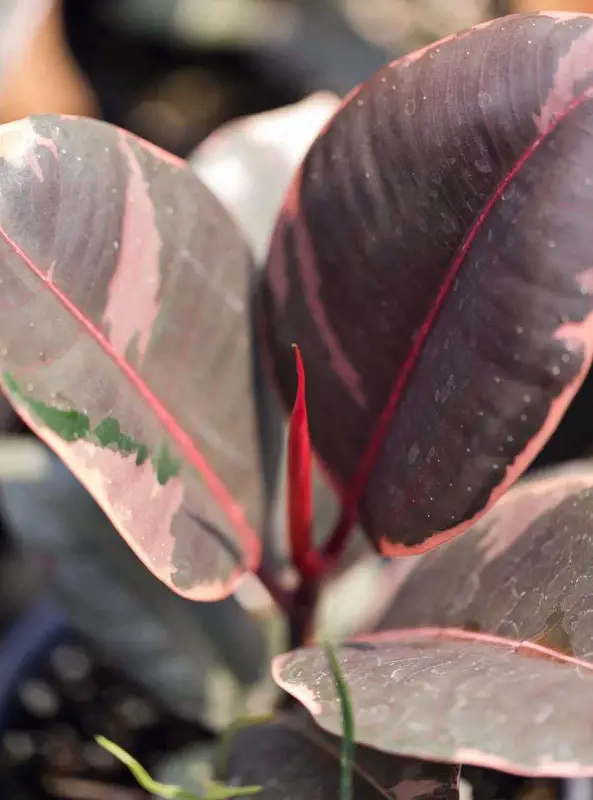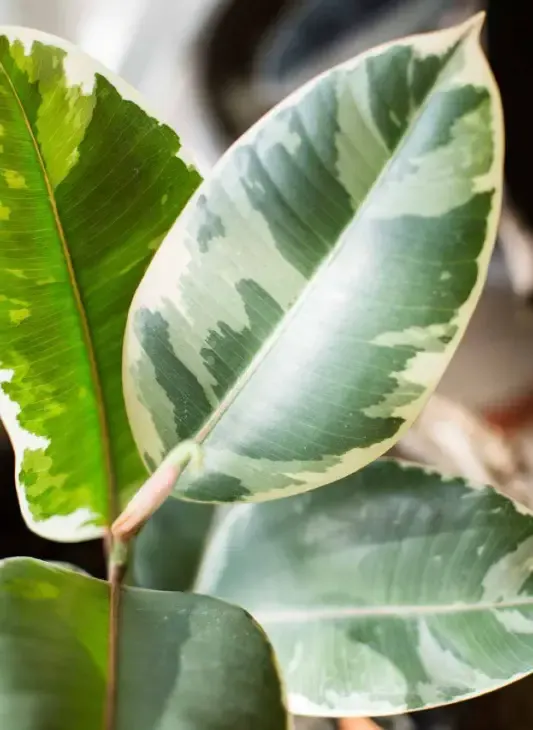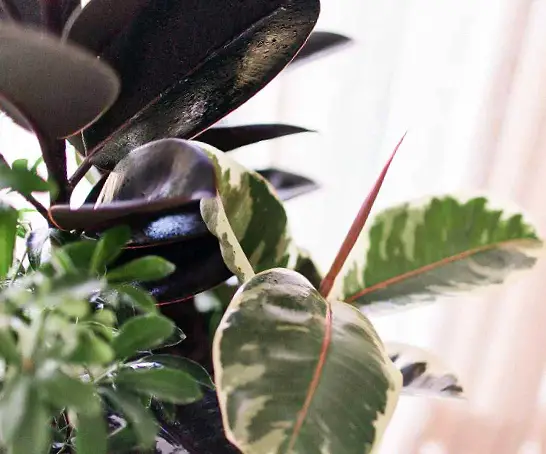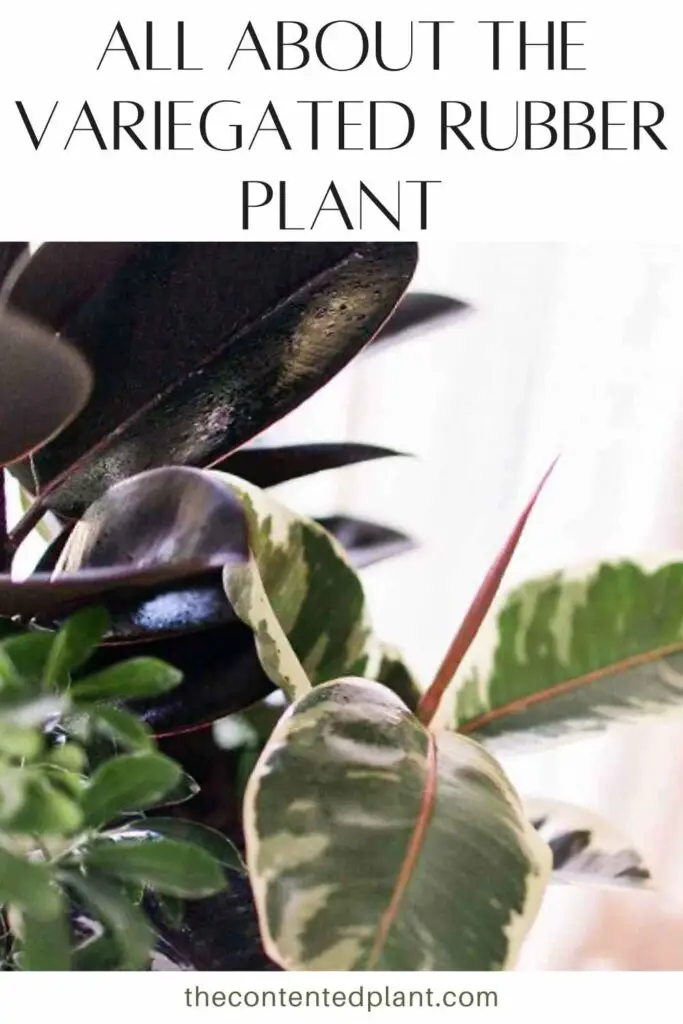The Variegated rubber tree (variegated ficus elastica ) is an eye catching regal variation on the solid colored cultivars of the rubber tree plant.
Rubber plants are very common, well loved houseplants. The care needs are simple.
This is a Great plant for Beginner Plant Parents.
You will find rubber plants in many local garden shops. And online as well.
Indoor rubber trees come in several colors in both solid and variegated forms. Deep Ruby red, black and green colors are the most common.
The variegated cultivars create a flashy column of lively color in your home.
We have a printable variegated rubber plant care guide at the bottom of this post.
It will help you with specific tips for the rubber plant’s care needs.

The rubber plant (ficus elastica) is related to the Fiddle Leaf Fig (Ficus Lyrata).
Rubber plants do enjoy many of the same conditions as the Fiddle leaf. However, it is not as fussy as its plant cousin.
Variegated Rubber Plant Growth Habit:
Rubber plants all grow straight up in a majestic column. So they require a relatively small foot print in your home.
A six foot high rubber tree has a diameter of less than three feet. Small indeed for a plant on this height.
I grew one to ceiling height in my very small home long long ago. It lived quite happily with TONS of plants grouped around it.
Rubber trees offer a welcome vertical line of color and texture to small rooms in your home.
They are great for boring corners and fit well behind sofas and in furniture groupings.
They do need enough light to grow well. Bright indirect light will do the trick. Do not expect them to enjoy dark corners.
If you want some presence in your living green world in a small space the rubber tree is a good choice. Other large plants like the money tree, the enormous elephant plant, or Huge Monstera vines, spread out and take up a good amount of floor space.
Even the dwarf umbrella tree, while not as tall, will use a larger foot print than the rubber tree.

Pruning a Rubber Tree:
The home cultivars of the rubber tree will grow 10 to 12 feet tall when happy. In the wild they attain heights of 80 to 150 feet if you can imagine that.
Rubber plants naturally grow straight up in a regal column. Unless you force them to bush by pruning them.
I eventually did cut the top off mine. If you do this, expect the top to grow TWO branches off the node just under your cut.
This makes a tall variegated rubber tree look unbalanced. Pruning the new growth works if you prune when the new shoots emerge.
If you pick up a small rubber plant, like those you see pictured here, you won’t have to worry about pruning it back for several years.
But eventually, Unless you have high ceilings, expect to prune it back to keep it off your ceiling.
Since a well maintained rubber plant can grow up to two feet in height a year…you might want to consider if this is the best option for your home, long term.
Or try training it to bush as a young plant if you have the room. It’s a very different look but still stunning.
You can always give it away to a vaulted ceiling home if you prefer not to cut the top off. 🙂


Shop Variegated Rubber Plants on ETSY:
If you are looking for a specific color variegation we recommend you shop on Etsy. These are small mom and pop shops that have specialty color variations you won’t easily find in the big box stores or even your local small garden shops.
Shipping in the winter months is sometimes problematic. Keep your plants searches as close to home as possible to avoid plant shocking temperatures during transport.
The variegated forms of the rubber plant will require more light than the solid green color. That’s true of all variegated plants. They must have chlorophyll to feed themselves.
As pretty as variegated plants are, without enough light to the green photosynthesizing parts they won’t do well for you.
Rubber Trees are all great at filtering the air in your home.
They are one of the best houseplants to improve your indoor air quality though oxygenation and filtering out home toxins.

Rubber Trees make a nice grouping with other balancing plants.
Rubber Trees are Toxic:
This plant is considered mildly toxic.
When cut or chewed, the stems secrete an irritating latex sap that is not good for your kids or pets. You will notice the sap can also irritate your skin. Gloves are recommended when pruning this plant.
Symptoms include loss of appetite, drooling, vomiting and diarrhea.
Variegated Rubber Plant Care:
The variegated rubber plant is a native of South and Southeast Asia. It is a tropical plant and does naturalize well in sub tropical climates like Florida, Sri Lanka and the West Indies.
However, It is best NOT to grow this plant outdoors in summer and then move it indoors. Rubber plants prefer consistency.
Wide changes of light and temperature are hard on them.
For success in growing this plant indoors, read all of our tips below. Once you learn it, The care for rubber plants is easy and the plant is pretty much trouble free if well maintained.
Variegated Rubber Plant Care Guide

Variegated Ficus Elastica Is a popular houseplant that grows as an indoor tree . This plant has beautiful large green variegated leaves.
The rubber plant grows straight up to the ceiling in a narrow column with large ovate waxy leaves. It's a striking statement plant.
The rubber plant will grow 10 to 12 feet tall (or more) indoors.
Learn all about Rubber Plants care in this guide.
Materials
Tools
Instructions
Soil Preference:
- Rubber plants require a light well draining soil.
- A mix of potting soil and perlite will keep the roots happiest. Or try using a 100% cactus soil mix.
- The regular soil/perlite mix is 40% potting mix to 60% perlite.
- A heavy soil potting mix is not recommended for Rubber Tree plants.
Pot Size and repotting:
- Rubber plants need to be planted in pots that fit the root size.
- Any well draining pot can be used. It MUST have drainage.
- Repot every second year or when roots come out the drainage holes on the pot bottom To the next pot size up.
- When repotting always choose a pot that is 2-3 inches larger in diameter than the previous pot.
- Lighting:
- rubber plants plants require 6-8 hours of bright indirect sunlight everyday for optimal growth.
- Turn the plant every few weeks to maintain even leaf growth
- East facing sunny windows are best for this plant. A north or south window can burn the leaves.
- Fiddle leaf figs cannot stand strong hot direct light. The leaves will burn and the plant will suffer.
Watering:
- Use distilled or filtered water or let your tap water sit at least 24 hours to neutralize harmful chemicals before watering your plants.
- Water your Ficus Elastica when the soil is dry down an inch or so. Rubber plants enjoy moist not WET soil.
- Watering is best done on a regular schedule (try weekly) so the plant is not over or under watered. Both can cause stress on the plant.
- This plant enjoys humidity. In dry climates rubber trees will thrive with a humidifier nearby. Or put it in your kitchen or bathroom if you have adequate light and floor space.
- In a dry climate frequent misting will help.
- In dormant winter months reduce watering as the plant will not need as much.
- Never let this plant get wet feet. If the soil is compacted the bottom of the soil can remain wet. This encourages root rot and fungus gnats.
- If you see yellow leaves on your rubber tree you are probably overwatering or the soil is too heavy.
- If the tips of the leaves turn brown suspect Underwatering. Or too dry air.
Humidity Tips:
- This plant likes a very humid environment. Mimic the conditions that it came from. Keep it around 40 to 60% humidity. If you find your plant needs a bit more humidity than your home provides...
- Add a humidifier close by the plant.
- Pebble trays also work great to help increase humidity around your plant as evaporation occurs.
- Grouping plants close together also helps them pick up humidity from each other as they respire.
- Finally get a good mister and regularly mist your plant leaves
How to Fertilize:
- Apply a good quality fertilizer (linked in materials) once or twice a month during growing season. This plant requires fertilizer to maintain the large green leaves.
- Decrease feedings by late Fall and allow plant to rest through the winter months.
- Look for brown spots on the leaves of your plants. This may indicate an over concentration of salts in the roots from over feeding. It can burn the leaves.
Temperature:
- Keep rubber plants at a low of 65 Degrees F. to upward of 85 Degrees F. It enjoys consistent temperatures along with warmth and humidity.
- AVOID drafts from heat vents or cold open windows.
Pruning:
- If your rubber tree is too tall for your home you can prune it. Pruning will result in the plant bushing out from the stem at the node below the cut into two branches.
- Cut the stem between two nodes.
- Severe pruning is not best practice.
- You can lightly prune off the offshoots that grow from cut stems to keep the plant at your preferred height.
Leaf Care:
- Rubber Plants enjoy monthly leaf washing. Washing the leaves periodically will keep the leaf pores (stomata) open so the plant can properly respire. Leaf washing also hydrates the leaf and removes pests that are trying to set up housekeeping on your rubber plant.
- Wash the leaves gently with water and Neem oil on a monthly basis. Neem oil leaf shine will give the leaves a wonderful shine and deter pests.
- Alternately, Milk is also a great leaf washer for adding shine to plant leaves.
- Be sure to wash the leaf top and bottom.
Pests:
- Rubber trees need to be checked periodically for pests.
- Stress by longterm overwatering, poor light, extreme temperatures and soil conditions are contributors to plant stress. And makes them more susceptible to pest damage.
- Spider mites, mealy bugs, scale, thrips and whitefly are the most common houseplant pests you will see.
- Read our post on How to get rid of aphids and other pests with our homemade pesticide soap recipe or neems oil.
- To minimize the possibility of pests be sure to check all nursery plants before bringing them home.
- Quarantine all new plants until you are sure no pests live in them.
Rubber Plant Propagation:
- Propagation is tricky and inconsistent. The best method is stem cuttings.
- Take a cutting from a stem that is at least 18 inches long with 2-3 leaves, and 2 nodes.
- Place cutting in jar with water, cut side down. You can also plant the stem directly in moist soil.
- Air layering will also work for rubber plant propagation.
- Roots will grow in 6-8 weeks.
- Plant when roots are at least 2-3 inches long.
Notes
Rubber trees are fairly straightforward to care for. However, there are a few things to look out for with your plant.
Signs that your Rubber Plant is not happy:
Large brown spots on leaves, this can be caused by root rot. If the plant is dropping leaves and the leaves are looking sick, check the roots.
If your variegated rubber tree has yellowing leaves suspect over watering.
If a rubber plant has brown tips on its leaves the air is too dry. misting and a humidifier are needed.
Leaves burned and/or rubber plant leaves in a too hot direct light. Remove to moderate indirect light.
This video for ficus lyrata (fiddle leaf fig) also covers the care needs for your Ficus Elastica (variegated rubber plant.
Related Posts:
Follow Us:
Find us on YouTube, Instagram , Pinterest and TikTok! We love to Plant chat. We also comment, like and occasionally share your content to our daily stories. We’d love to see your plants. Share your joy in your houseplants. Happy Planting!
Recent Posts:
Further Reading:
Intro to Ficus Trees by Stumpplant.com


Baby Rubber Plant Profile-Peperomia Obtusifolia - The Contented Plant
Sunday 24th of July 2022
[…] plant is called the baby rubber plant. Do not confuse it with the Rubber Plant (Ficus Elastica)which grows as a tree and reaches a stately 12 feet indoors. They both have strong rubbery textured […]
Ficus Benjamina (Weeping Fig) - The Contented Plant
Saturday 11th of December 2021
[…] Variegated Rubber Plant […]